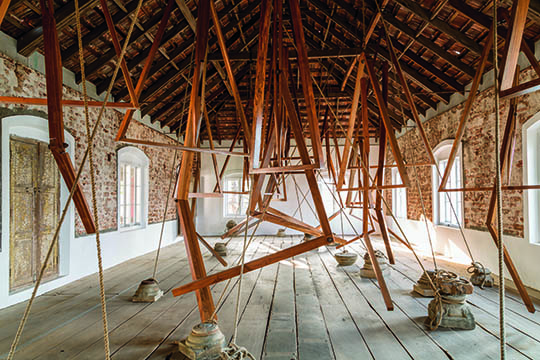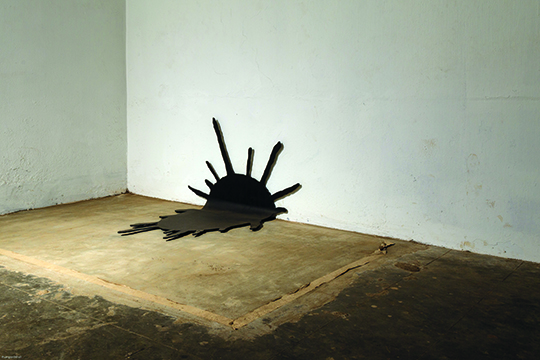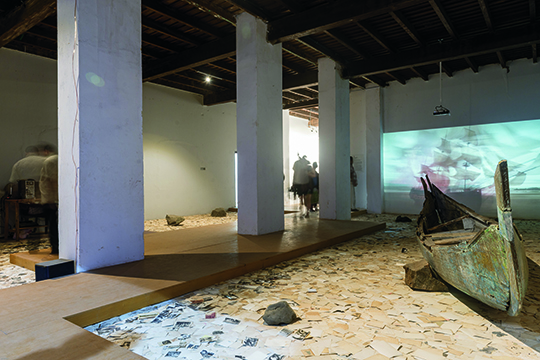WHORLED EXPLORATIONS: KOCHI-MUZIRIS BIENNALE 2014
| March 12, 2015 | Post In LEAP 31
MULTIPLE VENUES IN KOCHI, KERALA, INDIA
2014.12.12~2015.03.29

As one of only two biennials in South Asia, the Kochi Muziris Biennale is inevitably discussed in terms of its lack of government funding, although a printed guide—distributed in a timely fashion for the first time—lists its international patrons: Singapore’s National Arts Council, Hong Kong’s Burger Collection, the UAE’s Barjeel Art Foundation, Office for Contemporary Art Norway, and the Kerala government, among others. Given how problematic it is for Indian artists to locate funding at all, why feature nearly 100 artists in the first two editions? Why seek online crowdfunding over a more tightly curated exhibition with fewer venues? As one participating artist puts it, founders Bose Krishnamachari and Riyas Komu have heart. Instead of taking small, surefooted steps towards establishing a biennial for local audiences new to contemporary art, they persist in putting on events of astounding scale and breadth, including a student exhibition, collateral events, and public talks—the fact that the Biennale goes up at all elicits awe. As per this year’s curator, the artist Jitish Kallat, the strength of the Biennale is its fragility: “It’s about creatively befriending uncertainty and doing what we can with what we have.” The selection of Kallat as curator reinforces the position of the Biennale as an artist-led initiative that forcefully engages with the public outside of static spaces of speculation and transaction. With “Whorled Explorations,” Kallat takes cues from the history of Kochi as a maritime hub since the fifteenth century, but, while invoking an age of discovery, he also raises its unseemly aspects: subjugation, colonialism, and exploitation. His thoughtful brief is meant as a prompt for artists to consider their place in the universe and investigate collective conflicts.

Though several artists present disappointingly literal takes on the theme, a number of works surprise. Iqra Tanveer’s Paradise of Paradox utilizes light and dust as magical visual elements: in a dark room, handfuls of glittering sawdust are thrown into a beam of light that strategically frames a doorway. Beyond simply amusing visitors, Tanveer’s installation—fleeting, performative, and dramatic—hinges on the spiritual, making a poignant impression. In another venue, an inexplicable scent hangs heavy in the air; the source is Benitha Perciyal’s The Fires of Faith, which delves into the history of Christianity in Kochi by fusing frankincense, cloves, myrrh, lemongrass, cinnamon, and other elements into religious sculpture. In the humid climate, these delicately beautiful sculptures crack and disperse their odor. In the same venue, Prajakta Potnis’s Kitchen Debate recalls the debate between American Vice President Richard Nixon and Soviet leader Nikita Khrushchev; the work impressed the international visitors from whom many local players seek validation, but hardly outshines Perciyal’s work on cultural syncretism. Mithu Sen’s film I have only one language; it is not mine, shot with a shaky camera, odd filters, and abrupt edits, makes for a difficult viewing experience; although sincere in concept, the work is visually repelling.

Taken in total, the selection of artists is relatively safe, and some work is conceptually dry and visually sedate—perhaps a reflection of the curator’s sensibilities. Manish Nai’s empty formalism, for instance, sees indigo-dyed fabric crushed into a circular form, attempting nothing more ambitious than to evoke associations with nature. Much of the grit and gumption shown two years ago is now replaced with formalism, the polished language of accompanying wall texts aptly describing work that might not be up to par. Some work does carry on the ethos of the first edition of the show: Susanta Mandal’s stuffed sacks, placed in a dark corner and tied up with rope, emanate slow movements from within as if something within remains trapped but still breathing. Dinh Q. Lê’s installation Erasure combines found photographs, wooden boat fragments, and video, formal attributes evocative of the artist’s family history of emigration from Vietnam. Extending outward from the personal, Lê addresses the trauma of escape from conflict zones, launching into tumultuous journeys with uncertain consequences. Equally successful, Bharti Kher’s Three Decimal Points is a visually stunning yet conceptually terse installation of numerous larger-than-life cartographic instruments hung from the ceiling but tethered to the stone stumps of pillars on the floor. If the devices overhead signify western advances in science and imperialism alike, the stumps of Indian architectural history articulate the tensions and contradictions that cleave at our world today. Moving beyond the use of the bindis for which she is known, Kher’s transition here extends her critique of globalism and heralds a new direction for her practice.

In south Asia, a dearth of public funding and independent platforms underscores the importance of spaces for artists to respond to historic sites and experiment outside market pressure. Valsan Koorma Kolleri’s dig site and the very young Sahej Rahal’s innumerable mud and tar sculptures prove this point. With a lack of local public institutions for contemporary art, the south Asian art scene looks to art world personalities for validation; as Chris Dercon, director of the Tate Modern, presided over the BMW Art Talk at the opening, regional dealers and journalists paid close attention to which Indian artists he noted as exceptional. International attention on Kochi is, of course, a pertinent factor in the Biennale’s position as a vital force for art in south Asia. At its best, however, it is primarily an activator of agency: agency of artists to experiment without giving in to the market; of writers to grow into responsible critics; of the local community to participate, engage, and question. The Biennale is inclusive, and its survival is crucial. As its founders envision, “our biennial” is about art as a catalyst for artists, intellectuals, and audiences to challenge stagnant perspectives and take charge of their own narrative, offsetting deep cultural insecurities in the process.
Bharti Lalwani

